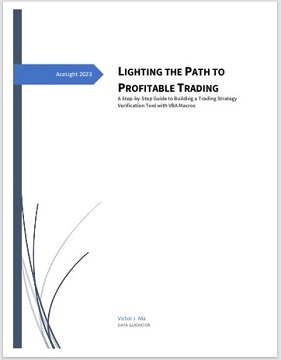A Simple Guide of Stock Market Diversification Strategy
|
|
Stock market diversification is like having a backup plan for your
investments, just like carrying an emergency pair of oversized clown shoes
in case your regular shoes get stolen by mischievous market elves. It's all
about spreading your investments across different stocks, sectors, and maybe
even different planets if Elon Musk decides to start trading Martian stocks.
The idea is to avoid putting all your money in a single basket, because
let's face it, even the most talented jugglers drop a ball from time to
time. And no one wants to be left scrambling for fallen investments while
wearing a red rubber nose, right?
In this article, we will explore
the importance of diversification, its benefits, and provide practical
insights and examples to help you create a robust portfolio. Whether you are
a novice investor or a seasoned trader, understanding the significance of
diversification is key to managing risk and maximizing returns.
Section 1: What is Stock Market Diversification?
Before we dive into
the nitty-gritty of diversification, let's start by defining what it means
in the context of the stock market. Diversification is a risk management
technique that involves spreading investments across various assets,
industries, sectors, and geographic regions. The objective is to reduce
exposure to any single investment and minimize the impact of market
fluctuations on the overall portfolio.
Section 2: The Benefits of
Diversification
2.1 Risk Mitigation By diversifying your portfolio,
you can mitigate the impact of individual stock price movements or market
sector downturns. If one investment performs poorly, the gains from other
investments may offset the losses, reducing overall risk.
2.2
Enhanced Returns Diversification can potentially enhance your investment
returns. By allocating funds to a mix of high-growth stocks, stable
dividend-paying companies, and low-risk assets, you can strike a balance
between risk and reward. A well-diversified portfolio may experience
steadier and more consistent returns over the long term.
2.3 Capital
Preservation Diversification helps protect your capital by preventing
overexposure to any single investment. By spreading your investments, you
reduce the risk of a substantial loss that could occur if you were heavily
concentrated in one stock or sector.
Section 3: Building a
Diversified Portfolio
3.1 Asset Allocation Begin by determining the
appropriate asset allocation for your portfolio. This involves deciding how
much of your capital should be allocated to stocks, bonds, cash, real
estate, or other asset classes. The ideal allocation depends on factors such
as your risk tolerance, investment goals, and time horizon.
3.2
Geographic Diversification Geographic diversification involves investing in
companies across different countries and regions. This strategy helps
mitigate the risk associated with a single market or economy. For instance,
if the domestic market experiences a downturn, investments in international
markets may provide stability and potential growth opportunities.
3.3
Sector Diversification Diversifying across sectors helps reduce the impact
of industry-specific risks. Industries can experience cyclicality or face
regulatory or technological disruptions. By spreading investments across
sectors such as technology, healthcare, consumer goods, and finance, you can
capture growth opportunities while minimizing sector-specific risks.
3.4 Individual Stock Diversification Within each sector, consider
diversifying your holdings by investing in a variety of individual stocks.
This strategy reduces exposure to the risk of any single company
underperforming. It is crucial to conduct thorough research, assess
financials, and consider factors such as market capitalization, growth
potential, and valuation when selecting individual stocks.
Section 4:
Diversification Techniques
4.1 Mutual Funds and ETFs Investing in
mutual funds or exchange-traded funds (ETFs) can be an efficient way to
achieve diversification. These investment vehicles pool funds from multiple
investors and invest in a diversified portfolio of stocks, bonds, or other
assets. Mutual funds and ETFs offer instant diversification, even with a
small investment.
4.2 Dollar-Cost Averaging Dollar-cost averaging
involves investing a fixed amount of money regularly, regardless of market
conditions. By investing consistently over time, you buy more shares when
prices are low and fewer shares when prices are high. This technique can
help reduce the impact of short-term market volatility and allow you to take
advantage of market downturns.
Section 5: Real-World Examples
5.1 The Tale of Lucy's Lemonade Stand
Let's dive into a whimsical
tale of Lucy, a young entrepreneur who decided to start her own lemonade
stand empire. Lucy invested all her savings into her lemonade business,
hoping that her secret recipe and sunny disposition would attract customers.
Unfortunately, the weather took a turn for the worse, and sales plummeted
faster than a soufflé in an earthquake.
Now, imagine if Lucy had
embraced the power of diversification. Instead of pouring all her money into
just one lemonade stand, she could have diversified her investment. Perhaps
she could have used some of her funds to buy a cotton candy machine or a
popcorn cart to offer additional treats. This way, even if lemonade sales
were slow due to bad weather, Lucy could have relied on the other
concessions to keep her business afloat. Lesson learned: diversification can
save your lemonade empire from turning sour.
5.2 The Dance of Bulls
and Bears
In the wild world of stock market investing, the battle
between bulls and bears can be quite the spectacle. Bulls charge ahead with
optimism, while bears growl with pessimism. Let's consider a real-world
example of how diversification could have softened the blow of a bear
attack.
Imagine an investor named Sam, who had put all his eggs in
one bullish basket by investing heavily in a single technology company.
Unfortunately, a sudden regulatory change sent the stock plummeting like a
bungee jumper without a bungee. If Sam had diversified his portfolio by
investing in different sectors such as healthcare, consumer goods, or
finance, he could have weathered the bearish storm more smoothly. By having
a diverse mix of investments, he would have been better positioned to handle
unexpected market events.
5.3 The Global Adventure
Let's
embark on a globe-trotting adventure with Maria, an intrepid investor
seeking fortune beyond her home market. Maria decided to embrace the spirit
of diversification by investing in companies across various countries and
regions. She invested in tech giants in the United States, automobile
manufacturers in Germany, and pharmaceutical companies in Switzerland.
When a political scandal shook the markets in her home country, Maria's
diversified portfolio acted as a safety net. While her local investments
took a hit, the international stocks she held remained resilient, providing
stability and potential growth opportunities. By spreading her investments
globally, Maria demonstrated the power of geographic diversification in
managing risks and capturing opportunities.
5.4 Market Sector
Downturns During market sector downturns, certain industries may face
challenges, while others may outperform. For instance, during the COVID-19
pandemic, travel and hospitality companies suffered significant losses,
while technology and e-commerce companies experienced growth. Diversifying
across sectors could have helped you navigate through these turbulent times
more effectively.
 Stock market diversification strategy is a powerful tool for investors to manage risk and enhance returns. By spreading investments across different assets, sectors, and geographies, you can reduce exposure to any single investment and potentially achieve more consistent and stable returns over the long term. Remember, the key is to develop a well-balanced portfolio tailored to your investment goals, risk tolerance, and time horizon. Stock market diversification strategy is a powerful tool for investors to manage risk and enhance returns. By spreading investments across different assets, sectors, and geographies, you can reduce exposure to any single investment and potentially achieve more consistent and stable returns over the long term. Remember, the key is to develop a well-balanced portfolio tailored to your investment goals, risk tolerance, and time horizon.
For any trading strategy, no
matter how good it sounds, we must test it before using it in the real
market. These tests include back-testing and forward-testing. Without proper
testing, trading will turn into guesswork or even worse, gambling. For more details, click
LIGHTING THE PATH TO PROFITABLE TRADING: A Step-by-Step Guide to Building a Trading Strategy Verification Tool with VBA Macros to get the whole tutorial handbook for free!
And click Free Trial to download strategies testing tools, all for a 30-day Free Trial.
Click on Subscription to order more strategies testing tools to help your stock trading.
Now that we've laughed our way through the world of stock
market diversification strategy, let's wrap things up with a punchline that
will leave you giggling all the way to the bank. Remember, diversification
is the key to success in the stock market, just like a clown car is the key
to success in a circus act. You want to make sure you have enough performers
to keep the audience entertained and coming back for more, but not so many
that they all get stuck trying to fit into a tiny car. So, grab your top
hat, hop into your clown car, and enjoy the ride towards financial success.
And if things ever get too stressful, just remember to honk your red nose
and take a deep breath. Happy investing, and may the laughs be with you!
|


|

Free Tutorial
Share
|
|
|
|